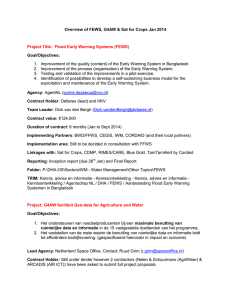
An increase of 21 per cent compared to this year. The United Nations Office for the Coordination of Humanitarian Aid (OCHA) in Sudan said in a report that about 11 million people need emergency assistance to meet life-threatening needs related to critical physical and mental health. For the latest news, Facebook, Twitter and Instagram.The number of people in need of humanitarian assistance in Sudan will rise to 15.8 million next year, equivalent to about a third of the population, which represents an increase of 1.5 million over this year. Restaurant menu screens are looking at you to decide what you might want to eat “There’s an increasing risk of wasting funds, spending funds in areas that aren’t the top priority.” “We need to be sure of the intentions of the data,” said Andrew Kruczkiewicz, an author of the study. The authors hope their research can be used to make FEWS NET and other efforts like it more accurate, so that funds can be routed to the neediest regions.

“We often think of rainfall and flooding, but the time period between when you have excess rainfall and when you have the floods is not so clear,” said Sonali McDermid, an author of the study.įailing to understand these nuances could result in some areas getting too much aid, and others not enough.Īs the push to anticipate disasters increases, more funding is going into early warning systems for humanitarian aid.
#Famine early warning systems network fews net driver
But in the case of a flooding, rain is just one driver that could affect food supplies. In the case of drought, no rain means no food. But FEWS NET does not take all of that into account, in part because governments do not report the effects of flooding in standardized ways.Īnother reason is a somewhat simplistic view of flooding. The impact of floods depends on their duration, location, and depth. Why flooding is less well understood than drought The reasons for the differences between the two assessments come down to what kind of data is being used, and how it is collected. Farmers are now warning the country may become dependent on food aid for its future food supply.Īccording to FEWS NET’s ranking, the flood-prone areas identified by the researchers fall within the “minimal” level of food insecurity. But its data differs from what the researchers found.įor example, their study shows that Nigeria, where recent flooding displaced over a million people, has areas where flooding can have a big impact on food systems. The World Bank relies on it for its own food insecurity warning system, the Famine Action Mechanism (FAM), along with many other countries and organizations looking for baseline information.įEWS NET classifies the level of food insecurity into five categories: minimal, stressed, crisis, emergency, and famine. It looks at a variety of factors, including agricultural production, weather, markets, and sociopolitical issues, to classify regions in acute need of food aid. What is FEWS NET?įEWS NET, or the Famine Early Warning System Network, was developed in 1985 by USAID and the US Department of State. Hot spots of flood impacts on food security include western and central South Sudan, northwestern Malawi, and along the Niger river in Nigeria. The researchers’ analysis found that flooding affected the food supplies of more than 5.6 million people in several African countries. It can also wash away crops, though sometimes it can be beneficial for them as well. Though flooding events have become more frequent and intense, their impact on food supplies is complicated to measure because they can have a variety of effects, ranging from positive to negative.įlooding can damage farming infrastructure, roads for shipping, mills where food is stored, and factories where food is produced.

3 ways to reduce invisible labor for women at workģ6 ways to build a family-friendly culture


 0 kommentar(er)
0 kommentar(er)
